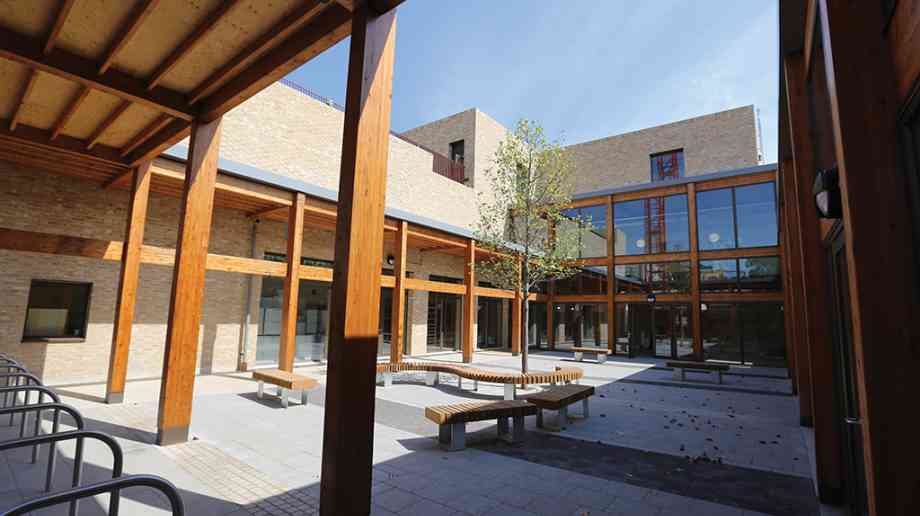
Embodied carbon in building projects
Embodied carbon is the total greenhouse gas emissions generated to produce a building and is a vital consideration when commissioning a sustainable new school, writes Natalia Ford from the UK Green Building Council
If you’re involved in the procurement and running of buildings, the chances are you know something about operational carbon emissions – the level of emissions produced from activities including heating, cooling and lighting buildings.
But embodied carbon is less well understood. However, as improvements are being made on operational emissions – through the introduction of energy efficiency measures in existing buildings and smarter design practices in new ones, coupled with de‑carbonisation of the grid – the relative significance of embodied carbon emissions on overall emissions related to buildings is increasing.
At the UK Green Building Council (UK‑GBC), our mission is to radically improve the sustainability of the built environment, by transforming the way it is planned, designed, constructed, maintained and operated. In our newest publication, we’re looking to provide guidance to those that procure buildings on how to commission an embodied carbon assessment.
What is embodied carbon?
Embodied carbon is the total greenhouse gas emissions (often simplified to ‘carbon’) generated to produce a building. This includes emissions caused by extraction, manufacture/processing, transportation and assembly of every product and element in that building. In some cases, (depending on the boundary of an assessment), it may also include the maintenance, replacement, deconstruction, disposal and end-of-life aspects of the materials and systems that make up the building. It excludes operational emissions of the building.
Why is it important?
The imperative for tackling climate change is clear. We must reduce our emissions globally to minimise the impacts of climate change and protect the environment for future generations. Governments across the globe are waking up to this, and last year saw the Paris Agreement come into force.
This historic international agreement to limit global temperature rise to well below two degrees Celsius above pre-industrial levels is a great commitment, but now we need to make it happen.
In the UK, the built environment sector needs to find a further 39 per cent reduction in carbon emissions from the 1990 baseline in order to meet the government’s target to reduce carbon emissions in the sector by 50 per cent by 2025. Longer term, deeper reductions will be needed to reach the UK’s Climate Change Act target of 80 per cent reduction by 2050 from a 1990 baseline.
Schools and embodied carbon
With the public purse strings pulled tight, those involved in commissioning buildings for education will be keen to demonstrate value beyond the bigger picture benefit of tackling climate change.
Many schools are already targeting environmental building standards such as BREEAM for their projects, and measures to reduce embodied carbon can count towards these certifications.
At the moment, consideration of embodied carbon hasn’t entered the mainstream for public procurement, this means that placing a requirement on the supply chain to reduce embodied carbon levels will encourage consultants and suppliers to step up to innovate and deliver a project that breaks new ground.
Using fewer materials is often an effective way of reducing embodied carbon, this means that the design team must design efficiently. This principle of requiring efficiency in design may also translate into cost savings for the client.
Recognising the importance of embodied carbon also sets a school apart as a leader in sustainability issues. As public awareness around issues affecting climate change increases, a commitment to measuring embodied carbon demonstrates to parents and pupils that the school is committed to sustainability.
Want to know more?
UK-GBC’s latest guidance is designed for those who need to write effective briefs for commissioning their first embodied carbon measurements. The guidance is appropriate for any capital investment intervention in the built environment including new build, refurbishment and renewal.
The guidance provides further information on embodied carbon and an overview of the reasons for choosing to assess embodied carbon. It gives practical advice on commissioning an assessment and provides example wording to work from.
Julie Hirigoyen, CEO of the UK Green Building Council comments: “UK‑GBC’s vision is of a built environment that is fully decarbonised. This has to include both embodied and operational carbon. As operational carbon reduces, the relative significance of embodied carbon increases. So we will continue to advocate for embodied carbon to become a mainstream issue in building design, construction and maintenance.
“Indeed, we will be encouraging our client members and other clients in the industry to create their own embodied carbon briefs by making effective use of this guidance.
“Also, through our work with cities and other local and national authorities, we will be encouraging the assessment of embodied carbon within the public sector planning and procurement process.”
You can access the UK Green Building Council guidance on the website below.
Further Information:Latest News
14/11/2025 - 11:04
England’s councils are warning of a "ticking time bomb" in the special educational needs and disabilities (SEND) system, with new data showing deficits that could bankrupt local authorities within three years.
13/11/2025 - 12:14
Event for school leaders, governors and education professionals relocates to the historic Old Billingsgate venue in London.
13/11/2025 - 09:49
The regulations have been set following a second consultation and detailed collaborative working with organisations and people across deaf and hearing communities.
13/11/2025 - 09:39
The Education Committee has published a letter to the Secretary of State for Education asking for more detail about the Department for Education’s work on developing its SEND reforms.
13/11/2025 - 09:26
New analysis by NFER has highlighted the uneven distribution of pupils with special educational needs and disabilities (SEND) across mainstream schools in England.







